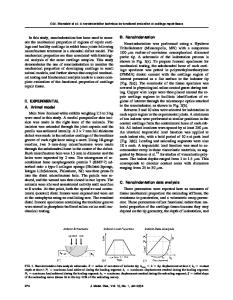A novel technique for the assessment of mechanical properties of vascular tissue
- PDF / 2,316,320 Bytes
- 10 Pages / 595.276 x 790.866 pts Page_size
- 18 Downloads / 354 Views
ORIGINAL PAPER
A novel technique for the assessment of mechanical properties of vascular tissue Stefan N. Sanders1 · Richard G. P. Lopata1 · Lambert C. A. van Breemen1 · Frans N. van de Vosse1 · Marcel C. M. Rutten1 Received: 6 June 2019 / Accepted: 14 January 2020 © The Author(s) 2020
Abstract Accurate estimation of mechanical properties of the different atherosclerotic plaque constituents is important in assessing plaque rupture risk. The aim of this study was to develop an experimental set-up to assess material properties of vascular tissue, while applying physiological loading and being able to capture heterogeneity. To do so, a ring-inflation experimental set-up was developed in which a transverse slice of an artery was loaded in the radial direction, while the displacement was estimated from images recorded by a high-speed video camera. The performance of the set-up was evaluated using seven rubber samples and validated with uniaxial tensile tests. For four healthy porcine carotid arteries, material properties were estimated using ultrasound strain imaging in whole-vessel-inflation experiments and compared to the properties estimated with the ring-inflation experiment. A 1D axisymmetric finite element model was used to estimate the material parameters from the measured pressures and diameters, using a neo-Hookean and Holzapfel–Gasser–Ogden material model for the rubber and porcine samples, respectively. Reproducible results were obtained with the ring-inflation experiment for both rubber and porcine samples. Similar mean stiffness values were found in the ring-inflation and tensile tests for the rubber samples as 202 kPa and 206 kPa, respectively. Comparable results were obtained in vessel-inflation experiments using ultrasound and the proposed ring-inflation experiment. This inflation set-up is suitable for the assessment of material properties of healthy vascular tissue in vitro. It could also be used as part of a method for the assessment of heterogeneous material properties, such as in atherosclerotic plaques. Keywords Ring-inflation · Constitutive modelling · Mechanical properties · Vascular tissue
1 Introduction Rupture of atherosclerotic plaques in the carotid artery is a major (15–20% of all cases) cause for stroke (Chaturvedi et al. 2005). Surgical removal of carotid plaques, endarterectomy, is the standard treatment for patients with severe This project is funded by the Dutch Foundation for Technical Sciences (STW) open technology program (STW #12548). Electronic supplementary material The online version of this article (https://doi.org/10.1007/s10237-020-01292-w) contains supplementary material, which is available to authorized users. * Stefan N. Sanders [email protected] 1
Department of Biomedical Engineering, Eindhoven University of Technology, PO Box 513, 5600MB Eindhoven, The Netherlands
carotid atherosclerosis. Currently, the severity of the stenosis is used to determine whether this procedure is necessary. A plaque resulting in a cross-sectional lumen area reduction larger tha
Data Loading...











